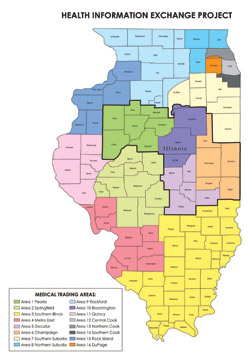Modernizing Healthcare Communication

Efforts are currently underway in Illinois to develop a health information exchange (HIE) to modernize healthcare communications. HIE allows healthcare providers with an electronic medical records system and patient permission to share health records across different computer systems. In February 2009, Governor Pat Quinn signed Senate Bill 1132 into law, appropriating $3 million to the Department of Healthcare and Family Services to establish a program for health information exchange planning.
The state was divided into 16 regions, with each area being awarded a one-year planning grant. In central Illinois, three grants were awarded to Quality Quest for Health of Illinois to coordinate planning for the Peoria, Bloomington and Decatur areas. A fourth grant, to the Champaign/Urbana Public Health District, is being used, in part, to pay Quest for managing their planning process as well. The three grants to Quality Quest totaled $529,688. The planning territory covers 20 counties and spans from Fulton County in the west, to the Indiana border in the east, and south beyond Decatur to Shelby County.
Experts have long recognized that sharing data among providers has a positive impact on safety and quality and lowers cost, but progress toward HIE has been a struggle for many communities across the U.S. Challenges have been technological (How many providers actually have electronic records?), financial (Who is going to pay for the exchange?) and political (Will healthcare competitors rally around a common cause for community good?).
The Benefits of HIE
Why is HIE important to the medical community in Peoria and central Illinois?
“The ultimate goal of an HIE system is to make patient health information completely portable so that no matter where a person goes for medical services, their physician will be able to immediately access the information that is needed to provide quality care,” says Joy Duling, HIE project manager.
The long-term benefits of health information exchange, where successful implementation has been achieved in states such as Rhode Island, Maine, Minnesota, and Nebraska, are:
- Improving healthcare quality and outcomes
- Reducing health disparities
- Reducing medical errors and duplicative services
- Enhancing coordination of patient care among providers
- Reducing or eliminating paper
- Controlling the cost of healthcare.
When Opportunity Knocks
Even before taking office in early 2009, President Barack Obama repeatedly emphasized his plan to have all U.S. residents covered by electronic medical records within five years. He followed through on that commitment with $59 billion in stimulus dollars for healthcare initiatives through the American Recovery and Reinvestment Act of 2009 (ARRA), including $19 billion specifically earmarked for healthcare information technology.
Under the new Act, physicians and medical practices can qualify for $44,000 or more in incentives if they can demonstrate “meaningful use” of an electronic health record by 2011. The formula for hospital incentives is more complex, but starts at a base of $2 million. On the back side, providers that do not implement an electronic health record (EHR) by 2015 will receive lower Medicare reimbursement.
There are three base requirements for meaningful use in the
new law:
- Use of certified or qualified EHR technology
- Electronic exchange of health information
- Use of EHR in reporting on clinical or other quality measures.
The promise of federal funds for providers in central Illinois is very real and quite imminent. The HIE planning currently happening under the auspices of Quality Quest is a critical component for positioning providers in our community to access the stimulus dollars. In short, central Illinois must have an HIE in place in order for providers to meet meaningful use requirements.
The Process
The planning team has worked diligently to establish governance structures, solicit provider collaboration and build the operational framework and social capital that will be necessary to sustain an HIE long-term. In the Peoria area, a Regional HIE Advisory Council meets monthly to provide local perspective to the planning. The Council includes representatives from local hospitals, health departments, health clinics, independent physicians, physical therapy services, behavioral healthcare, pharmacies, employers, insurance companies and consumers. Similar councils are providing input from Bloomington, Champaign and Decatur.
“We have six work groups made up of diverse stakeholders throughout the region who are examining issues from privacy and security to financial sustainability and technical infrastructure,” explains Duling.
A successful plan, then followed by implementation, would create a central Illinois HIE that would connect all healthcare providers across the 20-county area, creating a system of exchanging data for more than 1.3 million patients across 29 hospitals, 20 health departments and more than 2,100 physicians, pharmacies, laboratories and other healthcare settings. Long-term planning for interoperability with other regional HIEs will be essential, and Illinois is looking to local planning groups to make statewide health information exchange possible.
The central Illinois project is slated to submit its full HIE implementation plan to the Illinois Department of Healthcare and Family Services in July 2010.
Quality Quest is gathering information about the readiness of local providers for EHR and HIE. Focus groups involving physicians and practice managers, as well as healthcare practitioner surveys have taken place. Medical education programs are planned in mid-April for the Peoria, Bloomington and Champaign areas. Learn more at qualityquest.org. iBi

